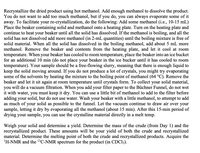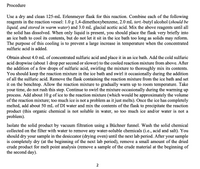
Chemistry
10th Edition
ISBN: 9781305957404
Author: Steven S. Zumdahl, Susan A. Zumdahl, Donald J. DeCoste
Publisher: Cengage Learning
expand_more
expand_more
format_list_bulleted
Question
lab Electrophilic
Can I get the explanation based of the lab
Why is it important to chill the reaction mixture during the addition of the concentrated sulfuric acid?

Transcribed Image Text:Recrystallize the dried product using hot methanol. Add enough methanol to dissolve the product.
You do not want to add too much methanol, but if you do, you can always evaporate some of it
away. To facilitate your re-crystallization, do the following: Add some methanol (i.e., 10-15 mL)
Place the beaker containing solid and methanol onto a heating plate. Turn on the heating plate and
continue to heat your beaker until all the solid has dissolved. If the methanol is boiling, and all the
solid has not dissolved add more methanol (in 2-mL quantities) until the boiling mixture is free of
solid material. When all the solid has dissolved in the boiling methanol, add about 5 mL more
methanol. Remove the beaker and contents from the heating plate, and let it cool at room
temperature. When your beaker has cooled to room temperature, place the beaker into an ice bucket
for an additional 10 min (do not place your beaker in the ice bucker until it has cooled to room
temperature). Your sample should be a free-flowing slurry, meaning that there is enough liquid to
keep the solid moving around. If you do not produce a lot of crystals, you might try evaporating
some of the solvents by heating the mixture to the boiling point of methanol (64 °C). Remove the
beaker and let it sit again at room temperature until crystals form. To collect your solid material,
you will do a vacuum filtration. When you add your filter paper to the Büchner Funnel, do not wet
it with water, you must keep it dry. You can use a little bit of methanol to add to the filter before
adding your solid, but do not use water. Wash your beaker with a little methanol, to attempt to add
as much of your solid as possible to the funnel. Let the vacuum continue to draw air over your
sample, letting it dry by evaporating all the methanol (about 15 min). After this 15-min period of
drying your sample, you can use the crystalline material directly in a melt temp.
Weigh your solid and determine a yield. Determine the mass of the crude (from Day 1) and the
recrystallized product. These amounts will be your yield of both the crude and recrystallized
material. Determine the melting point of both the crude and recrystallized products. Acquire the
'H-NMR and the 13C-NMR spectrum for the product (in CDCI3).

Transcribed Image Text:Procedure
Use a dry and clean 125-mL Erlenmeyer flask for this reaction. Combine each of the following
reagents in the reaction vessel: 1.0 g 1,4-dimethoxybenzene, 2.0 mL tert.-butyl alcohol (should be
liquid, and stored in warm water) and 3.0 mL glacial acetic acid. Mix the above reagents until all
the solid has dissolved. When only liquid is present, you should place the flask very briefly into
an ice bath to cool its contents, but do not let it sit in the ice bath too long as solids may reform.
The purpose of this cooling is to prevent a large increase in temperature when the concentrated
sulfuric acid is added.
Obtain about 4.0 mL of concentrated sulfuric acid and place it in an ice bath. Add the cold sulfuric
acid dropwise (about 1 drop per second or slower) to the cooled reaction mixture from above. After
the addition of a few drops of sulfuric acid, swirling the mixture to thoroughly mix its contents.
You should keep the reaction mixture in the ice bath and swirl it occasionally during the addition
of all the sulfuric acid. Remove the flask containing the reaction mixture from the ice bath and set
it on the benchtop. Allow the reaction mixture to gradually warm up to room temperature. Take
your time, do not rush this step. Continue to swirl the mixture occasionally during the warming up
process. Add about 10 g of ice to the reaction mixture (which would be approximately the volume
of the reaction mixture; too much ice is not a problem as it just melts). Once the ice has completely
melted, add about 50 mL of DI water and mix the contents of the flask to precipitate the reaction
product (this organic chemical is not soluble in water, so too much ice and/or water is not a
problem).
Isolate the solid product by vacuum filtration using a Büchner funnel. Wash the solid chemical
collected on the filter with water to remove any water-soluble chemicals (i.e., acid and salt). You
should dry your sample in the desiccator (drying oven) until the next lab period. After your sample
is completely dry (at the beginning of the next lab period), remove a small amount of the dried
crude product for melt point analysis (remove a sample of the crude material at the beginning of
the second day).
Expert Solution
This question has been solved!
Explore an expertly crafted, step-by-step solution for a thorough understanding of key concepts.
This is a popular solution
Trending nowThis is a popular solution!
Step by stepSolved in 2 steps with 1 images

Knowledge Booster
Similar questions
- 1. would you expect the relative rate of SE2 reactions to be faster or slower if a molecule of chlorine is used instead of bromine? Explain your reasoning? 2. why is the first step in an electrophilic aromatic bromination so much more endothermic than the first step in an electrophilic addition of alkene?arrow_forwardPlease help me with this question, it's urgent The reaction shown below does not follow the expected theory. Given what you learned about substitution/elimination, what is the expected mechanism this reaction should follow? Suggest why that is not what happens and give the actual product of the reaction.arrow_forwardWhich of the following is a correct statement regarding electrophilic aromatic substitution? A. Many suitable electrophiles are unreactive and can be stored for long periods of time prior to use. B. The carbocation intermediate will lose a proton to regain aromaticity, usually from a position other than the site of the electrophilic attack. C. Formation of the carbocation intermediate has a high activation barrier due to loss of aromaticity. D. Reformation of the aromatic ring has a low activation barrier and therefore occurs slowly. E. The carbocation intermediate has several resonance structures and is negatively charged.arrow_forward
- electrophilic aromatic substitution reactions. type op or m, to indicate if the group would be an op or meta director in b H H H H h H CH3 blank 1 blank 2 blank 3 blank 4 blank 5 blank 6 :O: HLYXHOX CH3 CH₂CH3 blank 7 -CH3 C=N: blank 8 blank 9 blank 10 blank 11arrow_forwardPlease don't provide handwritten solution......arrow_forwardIn the synthesis of methyl orange why do you add the reagents slowly and very precise. Why was this necessary?arrow_forward
arrow_back_ios
arrow_forward_ios
Recommended textbooks for you
 ChemistryChemistryISBN:9781305957404Author:Steven S. Zumdahl, Susan A. Zumdahl, Donald J. DeCostePublisher:Cengage Learning
ChemistryChemistryISBN:9781305957404Author:Steven S. Zumdahl, Susan A. Zumdahl, Donald J. DeCostePublisher:Cengage Learning ChemistryChemistryISBN:9781259911156Author:Raymond Chang Dr., Jason Overby ProfessorPublisher:McGraw-Hill Education
ChemistryChemistryISBN:9781259911156Author:Raymond Chang Dr., Jason Overby ProfessorPublisher:McGraw-Hill Education Principles of Instrumental AnalysisChemistryISBN:9781305577213Author:Douglas A. Skoog, F. James Holler, Stanley R. CrouchPublisher:Cengage Learning
Principles of Instrumental AnalysisChemistryISBN:9781305577213Author:Douglas A. Skoog, F. James Holler, Stanley R. CrouchPublisher:Cengage Learning Organic ChemistryChemistryISBN:9780078021558Author:Janice Gorzynski Smith Dr.Publisher:McGraw-Hill Education
Organic ChemistryChemistryISBN:9780078021558Author:Janice Gorzynski Smith Dr.Publisher:McGraw-Hill Education Chemistry: Principles and ReactionsChemistryISBN:9781305079373Author:William L. Masterton, Cecile N. HurleyPublisher:Cengage Learning
Chemistry: Principles and ReactionsChemistryISBN:9781305079373Author:William L. Masterton, Cecile N. HurleyPublisher:Cengage Learning Elementary Principles of Chemical Processes, Bind...ChemistryISBN:9781118431221Author:Richard M. Felder, Ronald W. Rousseau, Lisa G. BullardPublisher:WILEY
Elementary Principles of Chemical Processes, Bind...ChemistryISBN:9781118431221Author:Richard M. Felder, Ronald W. Rousseau, Lisa G. BullardPublisher:WILEY

Chemistry
Chemistry
ISBN:9781305957404
Author:Steven S. Zumdahl, Susan A. Zumdahl, Donald J. DeCoste
Publisher:Cengage Learning

Chemistry
Chemistry
ISBN:9781259911156
Author:Raymond Chang Dr., Jason Overby Professor
Publisher:McGraw-Hill Education

Principles of Instrumental Analysis
Chemistry
ISBN:9781305577213
Author:Douglas A. Skoog, F. James Holler, Stanley R. Crouch
Publisher:Cengage Learning

Organic Chemistry
Chemistry
ISBN:9780078021558
Author:Janice Gorzynski Smith Dr.
Publisher:McGraw-Hill Education

Chemistry: Principles and Reactions
Chemistry
ISBN:9781305079373
Author:William L. Masterton, Cecile N. Hurley
Publisher:Cengage Learning

Elementary Principles of Chemical Processes, Bind...
Chemistry
ISBN:9781118431221
Author:Richard M. Felder, Ronald W. Rousseau, Lisa G. Bullard
Publisher:WILEY